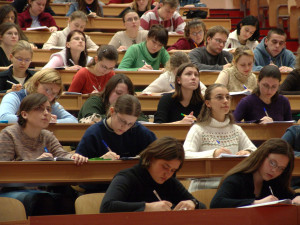 Secondary schools nationwide design curricula for high school classes that prepare a student for college. These programs fall in line with state and federal regulations that outline the subject matter to master for a standard or advanced diploma. Though class requirements may vary by state, core subject material covers similar components of math, English, science, social studies and technology. Electives are used to personalize and round out diploma requirements. High schools look to government initiatives, such as the Race to the Top and Common Core, along with state and regional needs to implement and align curricula with standards that provide students with the best preparation for college and career preparation.
Secondary schools nationwide design curricula for high school classes that prepare a student for college. These programs fall in line with state and federal regulations that outline the subject matter to master for a standard or advanced diploma. Though class requirements may vary by state, core subject material covers similar components of math, English, science, social studies and technology. Electives are used to personalize and round out diploma requirements. High schools look to government initiatives, such as the Race to the Top and Common Core, along with state and regional needs to implement and align curricula with standards that provide students with the best preparation for college and career preparation.
College Prep Classes for a Standard Diploma
Standard diplomas provide foundational coursework for acceptance into post-secondary programs offered by vocational schools, community colleges and some four-year institutions. The number of credits to earn a standard diploma ranges between 18 to 24 study units depending on the state. Instruction strives to help students not only acquire knowledge about topic areas, but to be able to use critical thinking skills to apply knowledge to solve problems. Instruction is often aligned according to the college standards students will be expected to understand. Standard diploma classes high school students are expected to master usually cover:
- Algebra and geometry
- English literature, composition and public speaking
- Biology, earth sciences and chemistry
- Geography, world history and government
- Technology education, including computer information systems
- Fine arts and foreign languages
- Physical education, health and driver education
- Personalized electives
A standard diploma curriculum acts as a starting place for students to begin high school studies with college in mind, especially for those who do not have defined career goals. Once students begin their secondary studies, it is not unusual for them to move into advanced high school classes that prepare a student for more academically challenging programs at larger universities.
Specialized Classes for College Programs
Advanced, high school diplomas prepare students for more rigorous post-secondary programs. Required classes and electives are typically instructed at the Advanced Placement (AP), International Baccalaureate (IB), or Science, Technology, Engineering and Math (STEM) levels. Examples of advanced diploma studies include:
- Trigonometry and calculus
- Cross-cultural literature, college writing or genre studies
- Journalism and broadcasting
- Psychology, anatomy and physiology, or behavioral health
- Physics, astronomy, horticulture or ecology
- Engineering, robotics or data programming
- Pedagogy, music theory, art analysis or theater production
Students who enter advanced diploma tracks typically have a career choice in mind or have pinpointed learning aptitudes for particular areas of study.
How to Choose Which High School Classes to Take
Secondary students usually meet with a guidance or career counselor prior to develop a four-year study plan and revise it annually. They will update career assessments and interest inventories to align their studies more accurately with post-secondary goals. These types of assessments are ongoing to reflect current learning aptitudes, interests and skills as they relate to college preparation studies.
Related Resource: College Teaching Assistant
Diploma requirements based on essential academic foundations prepare high school graduates with the college-and-career-readiness skills necessary to be successful in post-secondary endeavors. These foundations are constructed from government guidelines, regional needs and post-secondary recommendations. Personalized curriculum plans can then be designed featuring high school classes that prepare a student for college.
